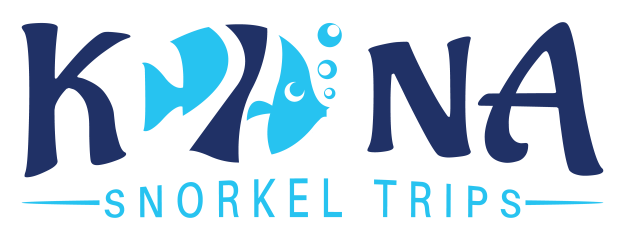Kona Manta Ray Night Snorkel: Ultimate Adventure Guide
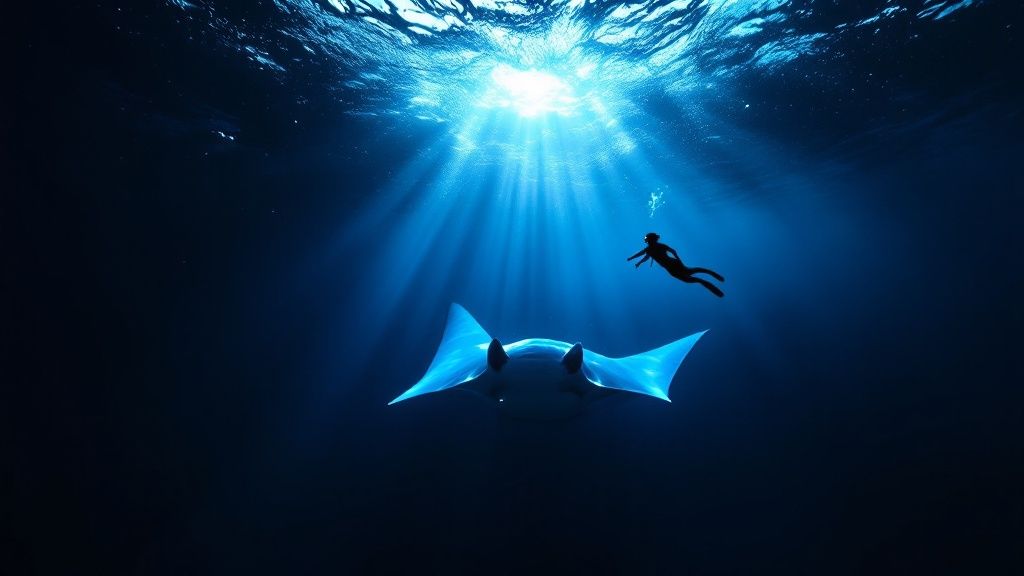
The Mesmerizing Magic of Kona's Manta Ballet
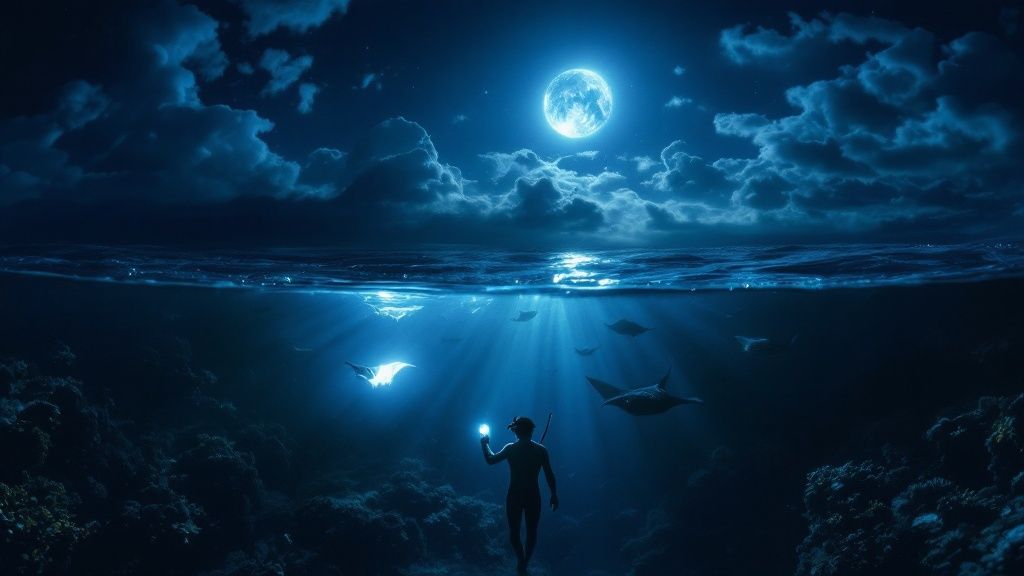
Discover the captivating world of Kona's manta rays. The Kona manta ray night snorkel, detailed in this guide, offers a truly immersive experience. Imagine yourself floating in the dark Pacific, illuminated by specialized lights, as enormous, graceful manta rays glide effortlessly below.
These gentle giants, some exceeding 1,000 pounds, perform a captivating underwater ballet. The experience creates a profound sense of awe and connection with the ocean. This isn't just a tourist attraction; it's a chance to witness these wild creatures in their natural habitat.
The Science Behind the Spectacle
Kona’s rich waters provide the perfect environment for this extraordinary encounter. The abundance of plankton, a crucial food source for manta rays, is a key factor. Tour operators use lights to attract plankton, drawing the mantas closer to the surface.
This creates a mutually beneficial situation: the mantas feast, and we get a front-row seat to their fascinating feeding behaviors. The Kona Coast is known for its frequent manta ray sightings, attracting an estimated 80,000 visitors each year.
The area is home to two manta ray species: the reef manta ray (Mobula alfredi) and the giant manta ray (Mobula birostris). The popularity of manta ray tours in Kona is largely due to the readily available plankton. You can find additional statistics on manta rays here.
Local operators have refined their techniques to optimize viewing opportunities while prioritizing the well-being of the manta rays. Organizations like Kona Honu Divers and Manta Ray Night Snorkel Hawaii are instrumental in ensuring responsible and ethical interactions. Other reputable tour operators, including Kona Snorkel Trips and Captain Cook Snorkeling Tours, also contribute to this unique opportunity to witness the magic of these gentle giants.
Prime Locations: Where Manta Magic Happens Nightly
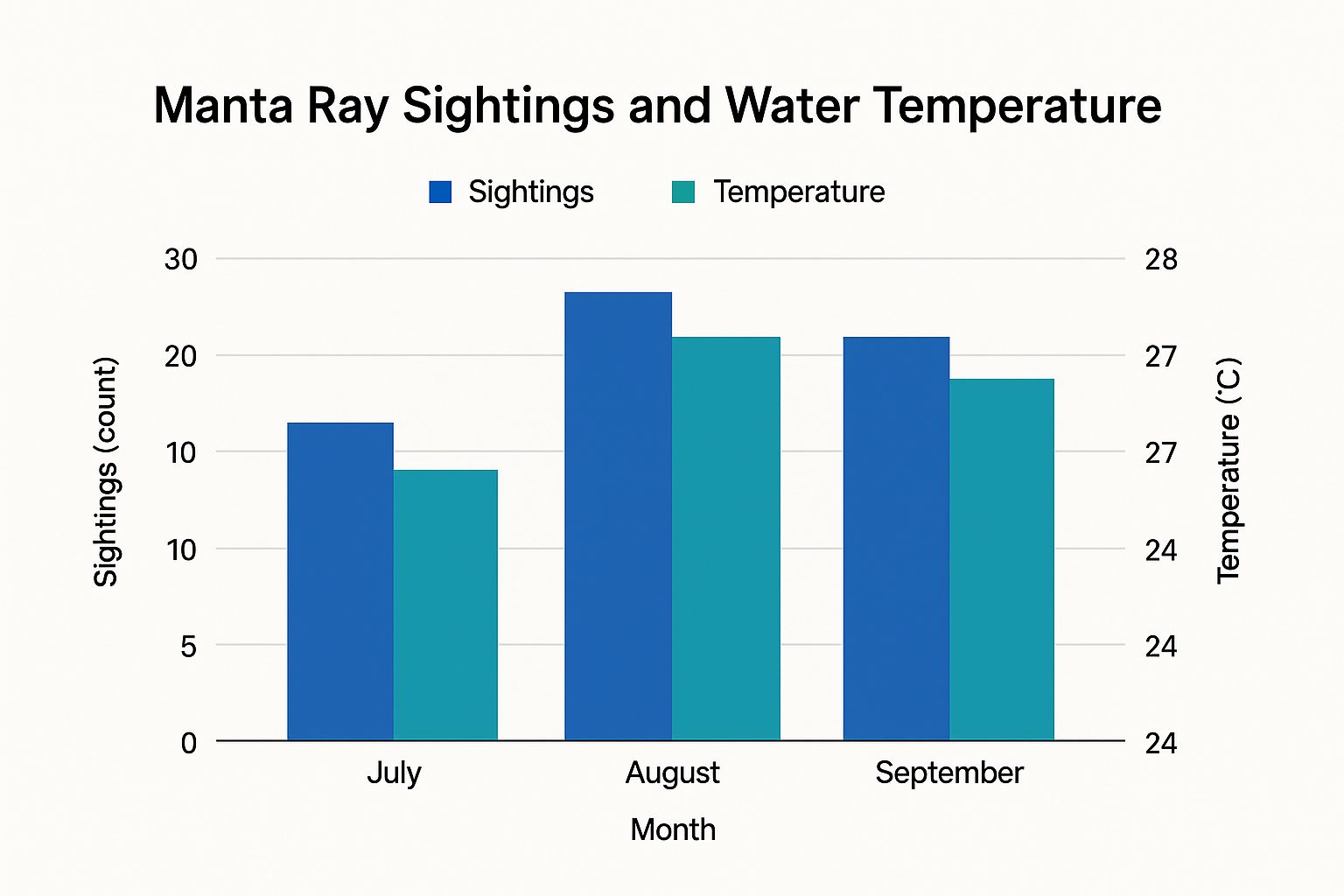
Kona is famous for its manta ray night snorkeling, but not all locations are equal. Two spots, Manta Village and Manta Heaven, consistently deliver unforgettable encounters. What makes these locations so special? The magic lies in the perfect blend of ocean conditions, underwater terrain, and the predictable feeding habits of these gentle giants. The data chart above highlights some key characteristics of these locations. Manta Village is generally shallower with calmer waters, while Manta Heaven offers a deeper, more dramatic experience.
Manta Village: Keauhou Bay's Shallow Spectacle
Manta Village, nestled in Keauhou Bay, is known for its shallow, accessible waters. This makes it perfect for first-time snorkelers and families. The bay's sheltered location usually offers calm conditions, ideal for watching the mantas perform their graceful underwater ballet. The shallow depth allows for excellent light penetration, enhancing the visibility of these incredible creatures.
Manta Heaven: Garden Eel Cove's Deep-Sea Drama
Manta Heaven, located at Garden Eel Cove, provides a different kind of experience. This deeper location often attracts more mantas, creating a truly awe-inspiring sight. The deeper water and possibility of stronger currents make this a better choice for more experienced snorkelers. For those wanting a truly immersive encounter, Manta Heaven offers something unforgettable. You can explore our sitemap for more information on the activities we offer.
Seasonal Patterns and Captain's Choice
Seasonal changes do affect manta ray sightings. Although you can see mantas year-round, certain times are more reliable. Experienced boat captains monitor the ocean conditions and manta ray activity, choosing the best location – Manta Village or Manta Heaven – for the optimal Kona manta ray night snorkel experience each night.
Kona’s special ecosystem supports a large manta ray population. On a typical night snorkel, you might encounter 5-15 rays, with wingspans reaching an impressive 12-16 feet. Over 120 individual mantas are identified yearly along the Kona Coast. Interestingly, the top 20 most sighted mantas account for almost 60% of all sightings. This shows a strong pattern of site fidelity, with mantas returning to the same feeding areas. This predictability is crucial for research and conservation efforts supported by local tour operators. More detailed manta ray statistics can be found here.
Comparing the Two Hotspots
To help you decide which location is right for you, we’ve created a table comparing Manta Village and Manta Heaven:
Kona Manta Ray Viewing Locations Comparison: A comparison of the two primary manta ray viewing locations in Kona with their unique characteristics and what to expect at each site
| Feature | Manta Village (Keauhou Bay) | Manta Heaven (Garden Eel Cove) |
|---|---|---|
| Average Depth | 15-20 feet | 30-40 feet |
| Water Current | Generally Calm | Can be Moderate to Strong |
| Visibility | Excellent | Very Good |
| Manta Density | Moderate | High |
| Skill Level | Beginner-Friendly | Intermediate to Advanced |
This table summarizes the key differences between the two locations. Manta Village, with its shallower depth and calmer currents, is ideal for beginners. Manta Heaven, while deeper and potentially subject to stronger currents, offers the chance to see larger groups of mantas. Choosing the right spot depends on your experience level and what you’re looking for in a manta ray encounter.
Prepping for Your Kona Manta Ray Night Snorkel
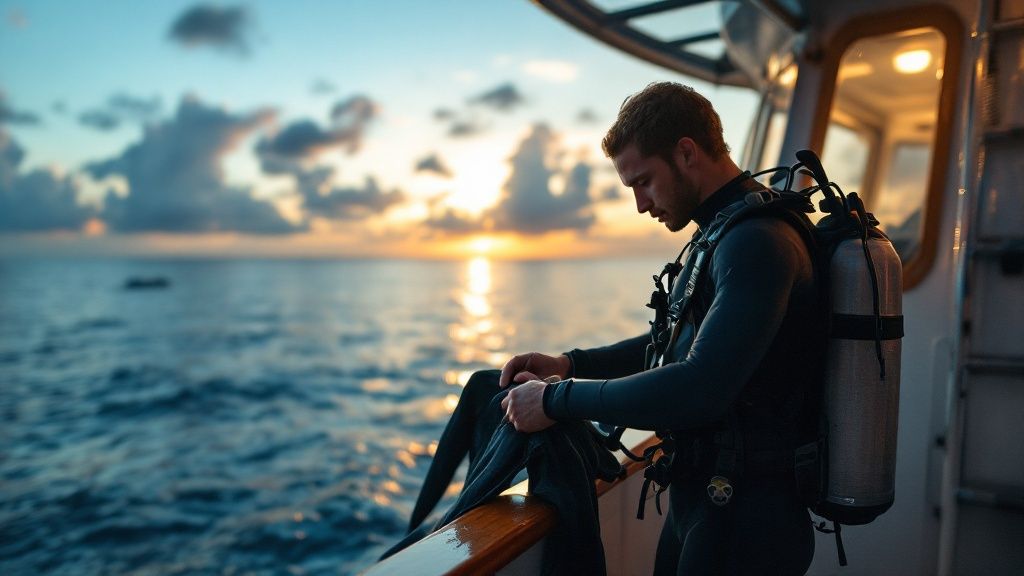
So you've booked your Kona manta ray night snorkel! What an incredible adventure awaits. This guide covers everything you need to know to prepare for a magical encounter with these gentle giants.
Essential Gear and What to Leave Behind
Most tour operators, like Kona Honu Divers, provide the essentials, such as a wetsuit and basic snorkeling gear. Bringing your own mask and snorkel, however, is a good idea for optimal comfort and fit. A wetsuit is crucial for warmth, even in Hawaii's waters, as nighttime temperatures can dip.
To make packing easier, we've created a handy table outlining what to expect from your tour operator and what you should bring yourself.
Before the table, here's a brief explanation of what you'll find: this table details essential items to pack for your manta ray night snorkeling experience, with notes on what's typically provided by tour operators versus what you should bring yourself.
| Item | Typically Provided? | Importance | Notes |
|---|---|---|---|
| Wetsuit | Yes | High | Keeps you warm and adds buoyancy |
| Mask & Snorkel | Sometimes | Medium | Bringing your own ensures a perfect fit |
| Towel & Dry Clothes | No | High | Essential for warming up after your snorkel |
| Seasickness Medication | No | Medium | Recommended if you're prone to motion sickness |
| Underwater Camera | Sometimes (for rent or purchase) | Low | Optional, but choose wisely if you want to capture photos/videos |
| Valuables & Electronics | N/A | N/A | Leave these behind! Focus on the experience |
After reviewing the table, you'll see that being prepared is key! Now, let's dive into some additional tips for getting ready for your manta ray adventure. Remember to bring a towel and dry clothes for after your swim. If you’re prone to motion sickness, especially on smaller boats, pack seasickness medication. Leave your valuables and unnecessary electronics on shore – the mantas deserve your undivided attention. You might be interested in: Learn more in our article about sitemaps.
Selecting the Right Underwater Camera
Want to capture your underwater encounter? GoPros are a popular choice, but make sure yours is securely attached to a floatation device. Some operators, such as Captain Cook Snorkeling Tours, offer photography packages. Waterproof phone cases are a budget-friendly alternative, but image quality might suffer in low-light conditions.
Mental Preparation and Comfort Techniques
Nighttime ocean conditions can feel a bit different. Visualize the experience ahead of time to ease any pre-snorkel jitters. Remember, your guides are trained professionals dedicated to your safety. Deep breathing exercises can also help calm your nerves and allow you to fully relax in the water.
From Booking to Floating: What to Expect
Once you've booked your tour with a reputable operator like Kona Snorkel Trips or Manta Ray Night Snorkel Hawaii, you'll receive clear communication about meeting points and times. Expect a thorough safety briefing onboard before arriving at the viewing site, often Manta Village or Manta Heaven. Your guides will position light boards in the water, attracting plankton, which in turn brings the mantas closer. Then, you'll enter the water.
The mantas' feeding behaviors, especially their graceful barrel rolls, are mesmerizing. Maintain a respectful distance and avoid touching the manta rays. This protects their sensitive mucus layer, which is crucial for their health. Respectful observation makes for a more natural and rewarding experience.
Maximizing Your Experience
The right operator makes all the difference. Experienced guides, small group sizes, and a commitment to ethical practices can greatly enhance your Kona manta ray night snorkel. Booking in advance, especially during peak season, is highly recommended. And don't hesitate to ask questions—a reputable operator will be happy to address any concerns. With a little preparation, you're ready for a truly memorable and meaningful interaction with these magnificent creatures.
Into the Blue: Your Manta Ray Night Experience Unveiled
Imagine the vibrant Kona sunset as your boat leaves the harbor. Anticipation builds as you head towards renowned manta ray night snorkel locations like Manta Village or Manta Heaven. This is where your manta ray adventure begins.
Setting the Stage: From Harbor to Open Water
The journey itself is part of the magic. As the boat cruises, the crew provides a thorough safety briefing. This covers everything from in-water etiquette to how the lighting system works, preparing you for a safe and memorable experience. These briefings are key to ensuring both your enjoyment and the well-being of the mantas.
Entering the Darkness: A Sensory Shift
Slipping into the dark ocean can be a surprisingly profound moment. The transition from light to dark, coupled with the gentle sway of the water, creates a unique sensory experience. Any initial hesitation quickly disappears as the guides skillfully deploy the light boards. These attract plankton, the manta rays' main food source, drawing these magnificent creatures closer.
The Manta Ballet Begins: A Dance of Grace and Wonder
The mantas appear as if by magic. These gentle giants, some with wingspans of 12-16 feet, emerge from the depths and glide effortlessly below. Their graceful movements resemble an underwater ballet, creating a truly mesmerizing spectacle. As they feed, they perform captivating barrel rolls, showcasing their agility and leaving a lasting impression. The guides ensure optimal viewing, allowing everyone a front-row seat to this breathtaking display.
Manta ray sightings are meticulously tracked to better understand their behaviors. Between 2009 and 2014, underwater videographers documented individual manta rays at sites like Manta Village and Manta Heaven. This data helps researchers and tour operators learn about movement patterns and improve visitor experiences. You can find more information about manta ray statistics here.
The Reality of Proximity: Debunking Myths and Misconceptions
The close proximity of the mantas is awe-inspiring. They glide within inches of you, offering an incredible view of their unique markings and graceful movements. However, it's crucial to remember that interaction is not encouraged. Touching the mantas is strongly discouraged as it can harm their protective mucus layer, which shields them from bacteria and parasites. Reputable tour operators like Kona Honu Divers and Captain Cook Snorkeling Tours emphasize responsible and respectful interactions with these magnificent creatures.
The Emotional Impact: A Memory for a Lifetime
The Kona manta ray night snorkel is more than just an activity; it's a deeply moving experience. The darkness, the gentle motion of the ocean, and the close encounter with these majestic creatures create a sense of wonder and a profound connection with the natural world. It's a memory that will stay with you forever. For more information on tours, you can visit Kona Snorkel Trips and Manta Ray Night Snorkel Hawaii.
Selecting Your Perfect Kona Manta Ray Night Snorkel: Beyond Price
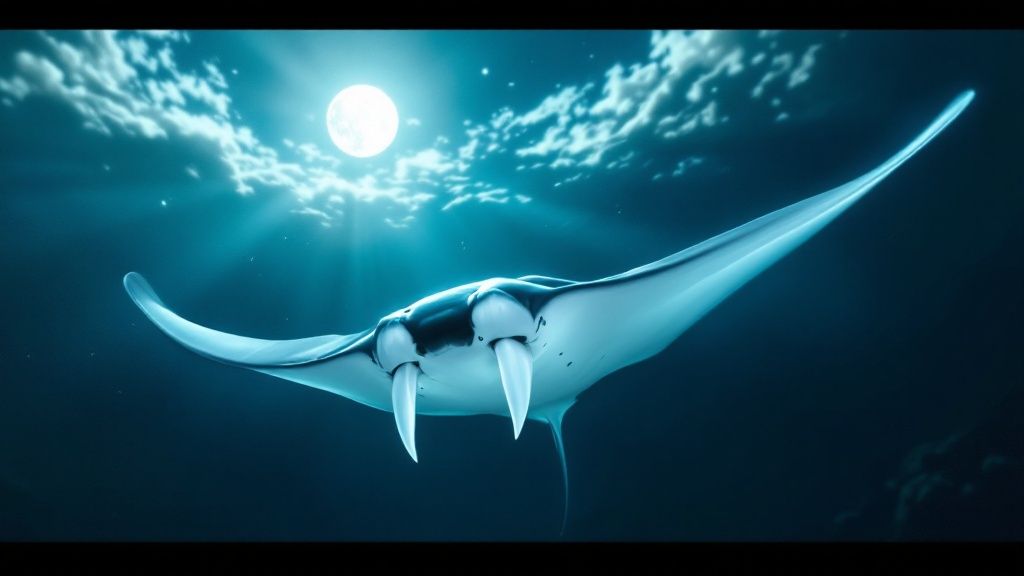
With so many tour operators offering manta ray night snorkeling in Kona, picking the right one can be a real challenge. But focusing on more than just the lowest price can unlock a truly unforgettable experience. Smart travelers know that the little things often have the biggest impact.
This means prioritizing factors like operator experience, group size, and marine conservation efforts.
Key Questions To Ask Before Booking
Choosing the right tour starts with asking the right questions. Inquire about the operator's history and how well their guides understand manta ray behavior.
It’s also vital to understand their safety measures and what happens in an emergency. Ask about their group size limits. Smaller groups usually mean more individual attention and closer looks at the mantas.
Don't forget to ask about their commitment to sustainable tourism. Responsible operators prioritize the health of the manta rays and their habitat. Finally, consider the type of boat. A larger, more stable vessel might be better if you're prone to seasickness, while smaller boats get to the manta ray viewing area faster. For more information about available tours, take a look at our activity sitemaps.
Boat Types, Group Sizes, and Guide Expertise
The kind of boat you’re on, how many other people are with you, and the guide's knowledge all contribute to your experience. Larger boats offer stability and comfort, while smaller boats can get to viewing spots more quickly. Smaller groups create more personalized interactions with guides and possibly even better manta ray viewing.
Experienced guides offer invaluable insights into manta ray behavior, deepening your understanding and appreciation of these magnificent creatures. Truly maximizing your experience comes down to understanding the impact of each of these elements.
Booking Timing, Refund Policies, and Added Value
When it comes to booking your Kona manta ray night snorkel, timing is key. Booking ahead, especially during busy times of the year, is strongly recommended. Make sure you understand the operator’s refund policy in case something unexpected happens.
Also, think about the extras some operators include. Some tours offer free photos or videos, while others might provide snacks and drinks. These perks can make your experience even better and create lasting memories.
Tailored Recommendations For Different Traveler Types
Every traveler has different needs. Families with small children may prefer shorter trips on stable boats geared towards beginners. Experienced snorkelers or underwater photographers might appreciate smaller groups and longer viewing times.
By understanding your own needs and asking the right questions, you can find the perfect Kona manta ray night snorkel trip. Operators like Kona Honu Divers and Manta Ray Night Snorkel Hawaii are a good starting point for your research.
Other reputable operators like Kona Snorkel Trips and Captain Cook Snorkeling Tours offer even more options. This personalized approach can turn an ordinary outing into a remarkable adventure.
Swimming With Giants: Conservation & Respect in Practice
The Kona manta ray night snorkel is an unforgettable experience. But with this thrill comes the responsibility to protect these graceful creatures and their fragile environment. This popular activity has a significant impact, and responsible tourism is key to the mantas' long-term survival. Want to explore more Kona snorkeling adventures? Check out this sitemap for additional information.
Identifying Individuals: Tracking Mantas and Their Stories
Every manta ray possesses a unique spot pattern on its underside, similar to a human fingerprint. Researchers and tour operators use these patterns to identify individual mantas, track their movements, and monitor their health. Local guides often give names to regularly sighted mantas, adding a personal touch to each encounter. This identification system is crucial for ongoing research and significantly expands our understanding of manta ray behavior. You might even spot a newly identified ray on your own snorkel trip!
Supporting Research and Conservation Through Tourism
The revenue generated from Kona manta ray night snorkel tours directly supports crucial research and conservation initiatives. Many tour operators actively participate in data collection, providing valuable information to ongoing studies. Visitor dollars also support local organizations dedicated to protecting manta rays and their environment. This symbiotic relationship between tourism and conservation helps ensure these incredible animals continue to thrive.
Operator Practices and Their Impact on Manta Well-being
Responsible operator practices play a vital role in manta ray well-being. These operators prioritize minimizing disruptions to the mantas' natural behavior. They carefully manage the number of boats at each viewing site and encourage respectful distances between snorkelers and the rays. Appropriate lighting techniques are also essential. Reputable operators like Kona Honu Divers and Manta Ray Night Snorkel Hawaii use lighting that attracts plankton without harming the mantas or the surrounding ecosystem.
Tourist Behavior: Surprising Influences on Manta Rays
While operator practices are crucial, tourist behavior also significantly impacts manta rays. Touching the mantas can disrupt their delicate mucus layer, which serves as a vital defense against bacteria and parasites. Even seemingly minor actions, like excessive splashing or loud noises, can cause stress. Responsible snorkeling practices, such as maintaining a respectful distance and avoiding sudden movements, are essential for positive interactions.
Ensuring Your Experience Contributes to Conservation
You can contribute to conservation efforts by choosing operators dedicated to sustainable practices. Look for companies adhering to responsible guidelines, such as those set by organizations like Kona Snorkel Trips and Captain Cook Snorkeling Tours. Learning about manta rays and their habitat before your snorkel can deepen your appreciation for these magnificent creatures and reinforce the importance of conservation. By being a mindful and respectful visitor, you can ensure your Kona manta ray night snorkel is both a thrilling adventure and a positive contribution to preserving these majestic animals.
Capturing the Magic: Photography in Challenging Waters
Photographing manta rays on a Kona manta ray night snorkel presents some exciting obstacles. Balancing capturing the beauty of these gentle giants with respecting their environment takes practice. This section explores the art of underwater night photography and offers expert advice for stunning images in these demanding conditions. Intrigued? Learn more in our article about sitemaps.
Choosing the Right Equipment
Your camera choice is fundamental for successful underwater night photography. Many snorkelers prefer GoPros for their compact size and robust build. Make sure yours has a reliable floatation device attached to avoid losing it to the depths. For superior image quality, consider a dedicated underwater housing for your DSLR or mirrorless camera.
Smartphones in waterproof cases can also take decent photos. However, their low-light performance often falls short. Auto-focus can struggle in the dark, and the resulting images might suffer from digital noise.
Mastering Settings for Movement in Dark Water
Standard photography rules often go out the window underwater. The low light combined with the manta rays' movement requires unique camera settings. A high ISO is essential for capturing sufficient light, but be prepared for some increased image noise. A fast shutter speed will freeze the mantas' graceful movements, preventing blur. A wide aperture is crucial for maximizing light capture. Experimenting with these settings before your dive will greatly improve your results.
Positioning and Lighting Techniques
The tour's lighting setup plays a critical role in your photo composition. Light boards, used to attract plankton, illuminate the manta rays, providing unique lighting opportunities. Position yourself strategically to make the most of this light. Shooting with the light source behind you can produce stunning silhouettes against the bright backdrop. Alternatively, facing the light source can reveal the intricate details of the mantas' undersides.
Post-Processing Magic
Post-processing can elevate your photos from good to breathtaking. Software like Adobe Lightroom or Adobe Photoshop allows you to fine-tune your images. Adjusting contrast, brightness, and sharpness can greatly enhance your underwater shots. Increasing contrast, for example, can make the mantas stand out against the dark water.
Alternatives to Photography: Staying Present in the Moment
While photographing these magnificent creatures is tempting, consider fully immersing yourself in the experience. Many tour operators, such as Captain Cook Snorkeling Tours, offer professional photo packages. This frees you to focus on the moment without the distraction of photography. Try memorizing the mantas' unique spot patterns, their graceful ballet, and the overall sensory experience. These memories can last even longer than a photograph.
Book Your Unforgettable Kona Manta Ray Snorkel Today!
Ready to witness the magic of manta rays firsthand? Book your Kona manta ray night snorkel with Kona Snorkel Trips today! We provide exceptional tours focused on guest experience and marine conservation, ensuring a memorable encounter with these gentle giants.
